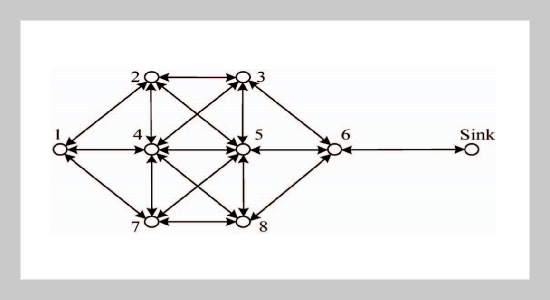REFERENCES
- [1] Akyildiz, I. F., Su, W. and Sankarasubramaniam, Y., “A Survey on Sensor Networks,” IEEE Communications magazine, Vol. 40, No. 8, pp. 102114 (2002). doi: 10.1109/MCOM.2002.1024422
- [2] Tanwar, S., Kumar, N. and Rodrigues, J. J. P. C., “A Systematic Review on Heterogeneous Routing Protocols for Wireless Sensor Network,” Journal of Network and Computer Applications, Vol. 53, pp. 3956 (2015). doi: 10.1016/j.jnca.2015.03.004
- [3] Rault, T., Bouabdallah, A. and Challal, Y., “Energy Efficiency in Wireless Sensor Networks: A Top-down Survey,” Computer Networks, Vol. 67, pp. 104122 (2014). doi: 10.1016/j.comnet.2014.03.027
- [4] Guo, W. and Zhang, W., “A Survey on Intelligent Routing Protocols in Wireless Sensor Networks,” Journal of Network and Computer Applications, Vol. 38, pp. 185201 (2014). doi: 10.1016/j.jnca.2013. 04.001
- [5] Al-Obaidy, M., Ayesh, A. and Sheta, A. F., “Optimizing the Communication Distance of an Ad Hoc Wireless Sensor Networks by Genetic Algorithms,” Artificial Intelligence Review, Vol. 29, No. 34, pp. 183 194 (2008). doi: 10.1007/s10462-009-9148-z
- [6] Jiang, H., Jin, S. and Wang, C., “Prediction or Not? An Energy-Efficient Framework for Clustering-Based Data Collection in Wireless Sensor Networks,” IEEE Transactions on Parallel & Distributed Systems, Vol. 22, No. 6, pp. 10641071 (2010). doi: 10.1109/TPDS. 2010.174
- [7] Tsai, C. H. and Tseng, Y. C., “A Path-connected-cluster Wireless Sensor Network and its Formation, Addressing and Routing Protocols,” IEEE Sensors Journal, Vol. 12, No. 6, pp. 21352144 (2012). doi: 10.1109/ JSEN.2012.2183348
- [8] Pai, H. T. and Han, Y. S., “Power-efficient Direct-voting Assurance for Data Fusion in Wireless Sensor Networks,” IEEE Transactions on Computers, Vol. 57, No. 2, pp. 261273 (2008). doi: 10.1109/TC.2007.70805
- [9] Luo, H., Tao, H. and Ma, H., “Data Fusion with Desired Reliability in Wireless Sensor Networks,” IEEE Transactions on Parallel and Distributed Systems, Vol. 22, No. 3, pp. 501513 (2011). doi: 10.1109/TPDS. 2010.93
- [10] Martinez, G., Li, S. and Zhou, C., “Wastage-Aware Routing in Energy-Harvesting Wireless Sensor Networks,” IEEE Sensors Journal, Vol. 14, No. 9, pp. 29672974 (2014). doi: 10.1109/JSEN.2014.2319741
- [11] Sajan, K. S., Kumar, V. and Tyagi, B., “Genetic Algorithm Based Support Vector Machine for On-line Voltage Stability Monitoring,” International Journal of Electrical Power & Energy Systems, Vol. 73, pp. 200208 (2015). doi: 10.1016/j.ijepes.2015. 05.002
- [12] Kuila, P., Gupta, S. K. and Jana, P. K., “ANovel Evolutionary Approach for Load Balanced Clustering Problem for Wireless Sensor Networks,” Swarm and Evolutionary Computation, Vol. 12, No. 10, pp. 4856 (2013). doi: 10.1016/j.swevo.2013.04.002
- [13] Jia, J., Chen, J. and Chang, G., “Energy Efficient Coverage Control in Wireless Sensor Networks Based on Multi-objective Genetic Algorithm,” Computers & Mathematics with Applications, Vol. 57, No. 11, pp. 17561766 (2009). doi: 10.1016/j.camwa.2008.10.036
- [14] Wei, T. and Wei, G., “Maximum Lifetime Genetic Routing Algorithm in Wireless Sensor Networks,” Journal of Software, Vol. 21, No. 7, pp. 16461656 (2010) (in Chinese).
- [15] Babaie, S. and Khadem, A., “A New Method for Improving Life Time in Wireless Sensor Network by Using Genetic Algorithm,” Advances in Intelligent & Soft Computing, Vol. 30, No. 8, pp. 177184 (2012).
- [16] Ming, D. G., Huan, Q. and Zheng, W., “Genetic Algorithm Based Routing Protocol for Wireless Sensor Networks,” Application Research of Computers, Vol. 27, No. 11, pp. 42264229 (2010) (in Chinese).
- [17] Rong, J. L., Xin, X. X. and Tian, X. S., “Energy Balancing Routing Algorithm in Wireless Sensor Networks,” Journal of Beijing University of Technology, Vol. 38, No. 5, pp. 740743 (2012) (in Chinese).
- [18] Long, C. and Long, C., “An Improved LEACH Multihop Routing Protocol Based on Intelligent Ant Colony Algorithm for Wireless Sensor Networks,” Journal of Information & Computational Science, Vol. 11, No. 2, pp. 415424 (2014). doi: 10.12733/jics20103577
- [19] Sara, G. S., Devi, S. P. and Sridharan, D., “A GeneticAlgorithm-Based Optimized Clustering for EnergyEfficient Routing in MWSN,” Etri Journal, Vol. 34, No. 6, pp. 922931 (2012). doi: 10.4218/etrij.12.1812. 0047
- [20] Zhang, H., Zhang, S. and Bu, W., “A Clustering Routing Protocol for Energy Balance of Wireless Sensor Network Based on Simulated Annealing and Genetic Algorithm,” International Journal of Hybrid Information Technology, Vol. 7, No. 2, pp. 7182 (2014). doi: 10.14257/ijhit.2014.7.2.08
- [21] Rana, K. and Zaveri, M., “Energy-efficient Routing for Wireless Sensor Network Using Genetic Algorithm and Particle Swarm Optimisation Techniques,” International Journal of Wireless & Mobile Computing, Vol. 6, No. 4, pp. 392406 (2013). doi: 10.1504/IJWMC. 2013.056548
- [22] Gupta, S. K. and Jana, P. K., “Energy Efficient Clustering and Routing Algorithms for Wireless Sensor Networks: GA Based Approach,” Wireless Personal Communications, Vol. 83, No. 3, pp. 24032423 (2015). doi: 10.1007/s11277-015-2535-7
- [23] Su, J. S., Guo, W. Z. and Yu, Z. L., “Fault-Tolerance Clustering Algorithm with Load-Balance Aware in Wireless Sensor Network,” Chinese Journal of Computers, Vol. 37, No. 2, pp. 445456 (2014) (in Chinese).
- [24] Heinzelman, W. B., Chandrakasan, A. P. and Balakrishnan, H., “An Application-specific Protocol Architecture for Wireless Microsensor Networks,” IEEE Transactions on Wireless Communications, Vol. 1, No. 4, pp. 660670 (2002). doi: 10.1109/TWC.2002.804 190
- [25] Feng, H. L., Yan, H. Q. and Ming, D. G., “Routing Protocol for Wireless Sensor Networks Based on Schema Theory,” Journal of Nanjing University of Science and Technology, Vol. 37, No. 3, pp. 331336 (2013) (in Chinese).
















